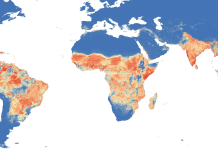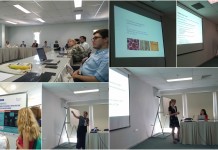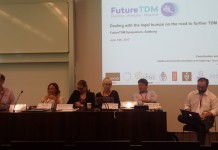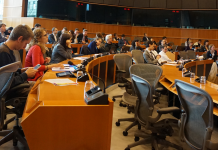As of October 7, 2016, the law on a Digital Republic (“République Numérique”) introduced an exception for text and data mining (TDM) in the French Intellectual Property Code. It comprises of two parts: a copyright exception and a sui generis database right exception. Both exempt reproductions made of works or databases to mine text and data from scientific literature (or associated with that), when there is lawful access to the source and absent any commercial purpose, although their respective wordings are slightly different. Moreover, both exceptions provide some safeguards and opportunities with regard to conservation and communication of any reproductions made in the TDM process after the TDM activities are carried out. In this blog post, I will shortly provide some of my observations of this exception.
General
As France lacked any exception covering TDM activities in its copyright and database regime before, the introduction of a TDM exception as such could be considered a step forward. As a result, the lawfulness of TDM under copyright and database law may be more certain in particular cases where such certainty – or lawfulness – did not exist before.
Very narrow scope
The scope of the French TDM exception finds its strong limitations particularly in two dimensions:
- The purposes for which TDM is carried out: only reproductions carried out for non-commercial research purposes are exempted.
- Mined subject matter: only the mining of text and data included in or associated with scientific literature is covered by the exception.
The first is not surprising, as similar constraints can be found already in the UK’s TDM exception. However, the second demarcation is more surprising and limits the applicability of the exception to quite a large extent. As a result, only scientific literature may be mined, as well as “text and data associated with” it. What the latter exactly entails, is not entirely clear. It is conceivable that it would, for example, include meta-data or datasets containing experimental data accompanying the journal articles. However, it is clear from this wording that anything not related to scientific publishing does not fall under the scope of this exception. This dramatically limits the use of the exception for science, since the benefits of TDM for scientific research goes way beyond the mining of scientific publications. Many other sources are valuable for scientists to mine, such as non-scientific literature (e.g. newspaper and novels), the whole World Wide Web (including specific services and platforms such as Twitter and Facebook) and any possible sort of digital content. From this point of view, it does not make sense to narrow down the scope to scientific literature.
Influence on European TDM exception
The French TDM exception might create an (undesirable) precedent for the TDM exception that is currently considered at the EU level. To prevent that they need to revise the French exception already in a short term, France may lobby at the Council of Ministers to adopt a similar exception at the EU level. Otherwise, it would have been better for France to wait for a European TDM exception, before adopting its current one. Whether France will really try to convince the EU legislator in this direction cannot be said with full certainty. If it does, the European TDM exception become much narrower in scope than is recently proposed by the European Commission.
It promotes reproducibility of TDM research
Within the FutureTDM project, we have spoken with many stakeholders in workshops, knowledge cafés, interviews and other events. One of the issues that kept being raised in conversations with TDM researchers, is that even with the existence of a TDM exception there may still be uncertainty about preservation of the copies made for the purpose of verification of the TDM research by other researchers. In the course of a TDM research project, reproductions may be made from several sources to combine into one dataset. Collections of works or data maybe transformed or annotated in order to make it ‘mineable’. Also, exploratory analyses may be carried out, resulting in different datasets that are in their turn mined in a final analysis. All in all, all these datasets may - in greater or lesser degree - contain elements that are protected by copyright or under the sui generis database regime. These are important outcomes that play a key role in case other researchers want to reproduce and verify this particular TDM research. Since verifiability is crucial in scientific research, reproductions for such purposes should be regarded as necessary for TDM research and, as such, should fall under the scope of a TDM exception.
The new French law potentially offers some safeguards to this end. The copyright exception refers to a decree to be issued, which may set out ways to preserve and communicate such outcomes. It also explicitly refers to these outcomes as “research data”. The database right exception similarly provides that a decree assigns bodies to take care of the conservation and communication of reproductions made of databases in the course of the TDM research activities. However, the actual effect will depend on the details of this decree, of which the pitfall is that it turns out to be a bureaucratic monster.
Looking at the exception proposed by the European Commission, its shortcoming is that the retention of these ‘verification’ copies is, in contrast to the French exception, quite uncertain and probably not allowed. On the one hand, it remains silent on any the possibility of preserving copies that are made in the TDM process. On the other hand, it does not say that reproductions made to carry out TDM may not be of a permanent character. However, recital 10 of the proposed directive explicitly and only refers to the current exception for temporary exception in this regard:
“The new exception should be without prejudice to the existing mandatory exception on temporary acts of reproduction laid down in Article 5(1) of Directive 2001/29”
This may suggest that reproductions for TDM in this directive are regarded rather as temporary reproductions. To promote progress in science, and in particular in sciences thriving on TDM technologies, clarifications on this matter would therefore be highly welcome.
Conclusion
To summarise, any legislative initiative that creates opportunities for an increased uptake of TDM (research) in Europe seems to be welcome. However, when it turns out to be very case specific legislation or only a national initiative, the barriers to TDM we face in Europe are not going to be solved. Hopefully, a TDM exception on the EU level will bring more hope. What a European TDM exception could learn from its French counterpart, is to guarantee that the exception will be of use to TDM and scientists, who need to be sure that their research can be verified without infringing copyright; of course, this requires a thoughtful approach, since abuse of such rights must be prevented. After all, the verification of research is an essential part of carrying TDM in a scientific research context. The Commission must ensure that retention of copies for verification purposes in science are allowed under a future TDM exception.
// All blog posts are the personal opinion of the bloggers. For more information see FutureTDM's DISCLAIMER on how we handle the blog. //













